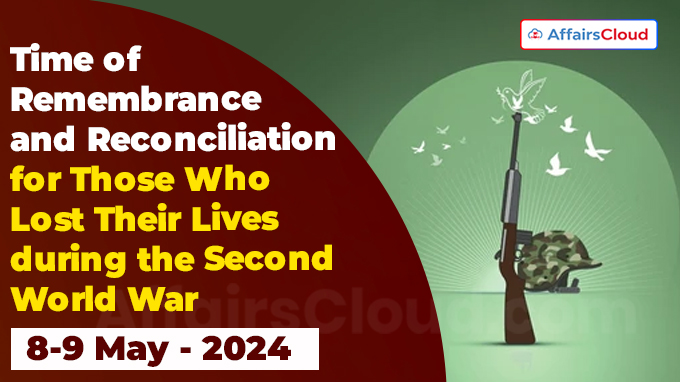 The United Nations (UN) annually marks the 8th and 9th of May as the Time of Remembrance and Reconciliation for Those Who Lost Their Lives during the Second World War, to pay tribute to all victims of the Second World War (WWII) (from 1939 to 1945).
The United Nations (UN) annually marks the 8th and 9th of May as the Time of Remembrance and Reconciliation for Those Who Lost Their Lives during the Second World War, to pay tribute to all victims of the Second World War (WWII) (from 1939 to 1945).
- The day was designated to pay tribute to the deaths of 40 million civilians and 20 million soldiers by promoting reconciliation.
2024 marks the 79th anniversary of the end of the Second World War.
Note: The Second World War is known as the Great Patriotic War in Russia.
Background:
i.On 22 November 2004, the UN General Assembly (UNGA) adopted the resolution A/RES/59/26* declaring 8–9 May as a Time of Remembrance and Reconciliation for Those Who Lost Their Lives during the Second World War.
ii.The UNGA invited all Member States, UN system organisations, non-governmental organizations (NGOs), and individuals to observe annually either one or both of these days to pay tribute to all victims of WWII.
iii.2005 marked the 60th anniversary of the WWII (also the 60th anniversary of the UN).
Resolution and Commemoration:
i.On 2 March 2010, the UNGA adopted the resolution A/RES/64/257 inviting all Member States to observe May 8–9 to pay tribute to war victims.
ii.A special solemn meeting in the 2nd week of May 2010 marked the 65th anniversary of the end of WWII, emphasising its immense toll on humanity.
Significance of 8th May:
i.8 May marked the end of World War II in Europe in 1945. The Day is known as Victory in Europe Day or V-E Day.
ii.On May 8, 1945, the Allies of WWII, including the United Kingdom (UK), the United States of America (USA), and the Union of Soviet Socialist Republic (USSR), accepted Germany’s unconditional surrender of its Nazi forces, marking the end of WWII in Europe.
Surrender Signings of Nazi Germany:
There were 2 surrender signings.
i.The 1st was on 7 May 1945, when German Col. Gen. Alfred Jodl signed Germany’s surrender on all fronts in Reims, France.
ii.The second signing was made by German Field Marshal Wilhelm Keitel, insisted upon by Soviet Premier Joseph Stalin, on May 8, 1945, in Berlin, Germany.
World War II:
i.The Second World War was fought between the Allies and the Axis powers.
- The Allies led by the UK and her Empire, the USA, the USSR, and France; Nazi Germany, Fascist Italy, and Imperial Japan were part of the Axis Powers.
ii.The war was fought in many parts of the world, including Europe, Asia, Russia, and North Africa.
iii.In August 1945, the USA dropped atomic bombs on Hiroshima, and Nagasaki in Japan which ended World War II.




